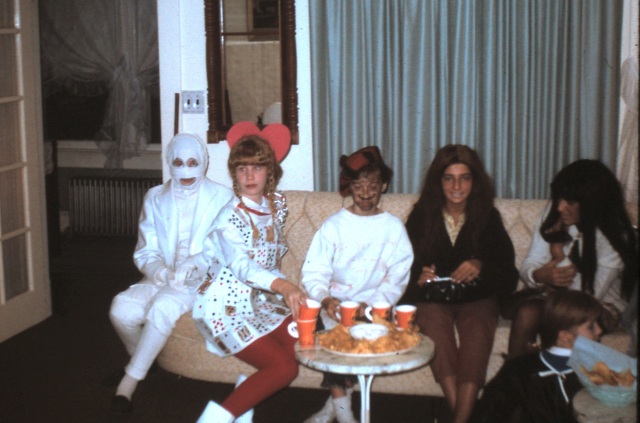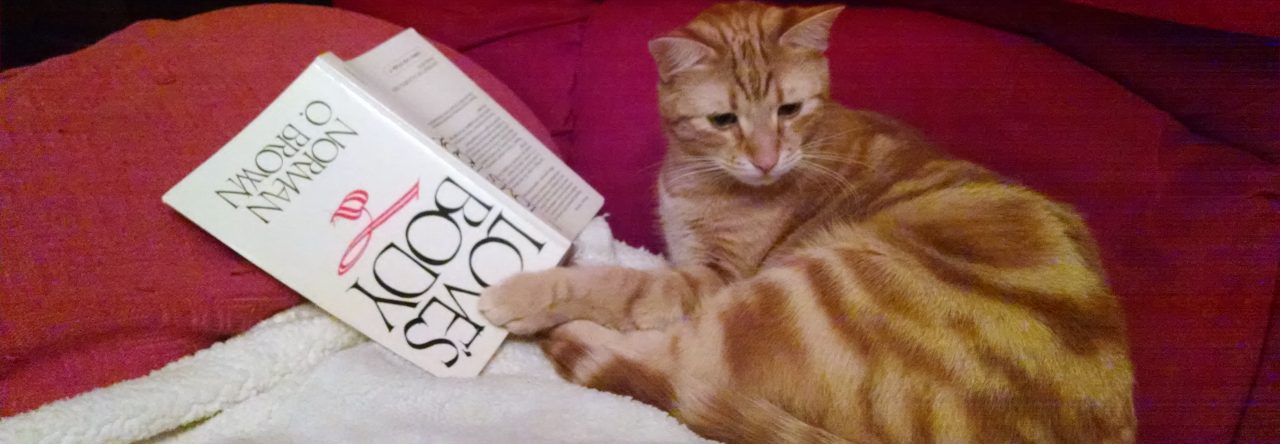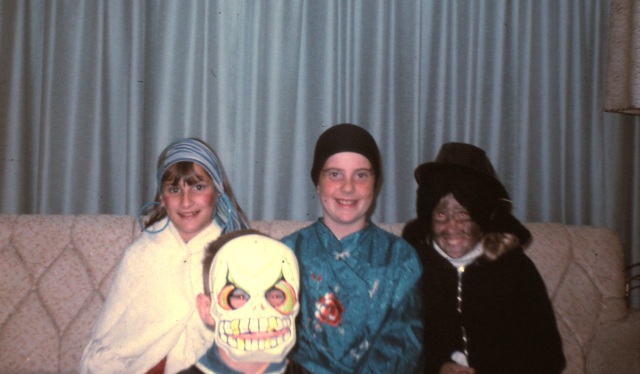Growing up on Long Island in the Sixties, I have fond memories of celebrating Halloween with family, neighborhood friends and school mates. To be outside at night in the cold and dark was an adventure. It was a time when knocking on the doors of neighbors, some rarely seen, and catching a glimpse of their lives was mysteriously tolerated.
Halloween didn’t start on October 31st, but in the preparations that took place in the weeks before. First, we would have to come up with an idea for a costume, which included time spent imagining who we wanted to be this year. This was my favorite part never having had a clear sense of who I was anyway – so I enjoyed thinking about characters that had caught my fancy and what it would take to assume their likeness. Although we did occasionally purchase a costume in the store, often times we made our own.
 And, because my big sister’s birthday was October 28, she usually had a party with her friends where I could at least tag along to see what the big kids were up to. There was a lot more to Halloween than just the big day of Trick or Treating.
And, because my big sister’s birthday was October 28, she usually had a party with her friends where I could at least tag along to see what the big kids were up to. There was a lot more to Halloween than just the big day of Trick or Treating.
It was around Halloween that my neighbor friend Regina, invited me over to watch a movie that she liked. Regina loved movies, and for the most part I shared her tastes although it was a struggle for me to endure watching four hours of Gone With the Wind with her.
That day we watched To Kill a Mockingbird, a movie we both came to love so much that we looked forward to watching it again every Halloween season. Except for the last scene, the movie didn’t have that much to do with Halloween, or did it? The ending scene takes place near Halloween and finds siblings Jem and Scout walking alone in the woods returning home from a school pageant. Scout, dressed up as a ham, is walking home with Jem when they are viciously attacked by Bob Ewell, the father of Mayella Violet Ewell, the accuser in a trial in which the children’s father, attorney Atticus Finch, defends Tom Robinson, a black man Mayella accused of raping her. The children are rescued by the mysterious neighbor Boo, who they had never seen before but had only heard stories about. Boo must have followed the children to the pageant and so is able to defend them from Bob Ewell’s attacks as the children make their way home.
As a child watching this film, I loved Scout’s character; a feisty young tomboy, ever curious and not very fond of conventions like wearing a dress to school. The movie’s depiction of the rural south in the 1930’s intrigued me with its poignant portrayal of racial tensions and the blatant mistreatment of blacks. This was something I was vaguely aware of from my parents, but had not seen firsthand in my northeastern home in NY.
Watching this film in later years I have  come to appreciate the social relevance of the film, not only for the awful plight of Tom Robinson and blacks in general, but also for the character of Boo, a man who might be too sensitive for this world, rumored to only go out at night and ironically feared by the children for never having seen or known him except through stories and rumors.
come to appreciate the social relevance of the film, not only for the awful plight of Tom Robinson and blacks in general, but also for the character of Boo, a man who might be too sensitive for this world, rumored to only go out at night and ironically feared by the children for never having seen or known him except through stories and rumors.
The movie is a perfectly fitting reminder that Halloween remains relevant to us as it invites us to try on other costumes and imagine ourselves in someone else’s shoes, especially those we don’t understand. As well, Halloween is yet another convergence of pagan (Celtic or possibly Germanic) sensibilities that found their way into western christianity, primarily through Catholicism. Catholics adopted All Saints Day as a holy day in remembrance of the dead to coincide with the pagan celebration of Samhain, the time of the year leading into the dark winter months when both the gods of the harvest and the ancestors needed our attention, propitiation and participation in the cycle of life.
From Wiki:
 “At Samhain, it was believed that the Aos Sí needed to be propitiated to ensure that the people and their livestock survived the winter. Offerings of food and drink, or portions of the crops, were left for the Aos Sí.[31][32][33][34] The souls of the dead were also said to revisit their homes.[35] Places were set at the dinner table or by the fire to welcome them.[36] The belief that the souls of the dead return home on one night or day of the year seems to have ancient origins and is found in many cultures throughout the world.”
“At Samhain, it was believed that the Aos Sí needed to be propitiated to ensure that the people and their livestock survived the winter. Offerings of food and drink, or portions of the crops, were left for the Aos Sí.[31][32][33][34] The souls of the dead were also said to revisit their homes.[35] Places were set at the dinner table or by the fire to welcome them.[36] The belief that the souls of the dead return home on one night or day of the year seems to have ancient origins and is found in many cultures throughout the world.”
This day of the dead, All Saints day, has more recently been associated with the occult and demons, or those spiritual beings who would harm us. Halloween in some protestant churches is now known as Reformation Day, celebrating their separation from the Catholic church. But I think the sensibility found in post-reformation theology that holds to the view that the dead are no longer with us, resting in Abraham’s bosum; untouchable and unknowlable to us, might have more to do with keeping clear the separation between the spiritual and material realms. A preference for dayworld over the underworld suggests that nothing immaterial can be trusted; all spirits are demons. I often wonder how much this theology has led to the materialistic view so prevalant in western science and modern culture that says that nothing unseen exists.
But, when we close ourselves off to the spirit world, we let go of the ancestors too; their history, wounds, sufferings and especially our living connection to them which remains hidden in us, haunting our world.
Let the mockingbird remind us through her ability to mimic the song of many birds how much we might glean with eyes open for all that is seen and unseen, especially from the dead – whose struggles, fears, failings, dreams and humanity may show us something about ourselves – something hidden, afraid to come out of the house, something we need to know.


I grew up in Elmhurst, Queens. My folks are still there. I’ve had a poem about that place in my head for some time now. I’m a Stuyvesant High alum. I never caught the movie but could see how those scenes would lend themselves well to a Halloween tale.
LikeLike
Hey you’re just a LI railroad train ride away from where I grew up. 🙂
The movie is a great example of the best of old-style b&w movies.
Thanks for the note!
LikeLike
The oldies remain the best. The black & whts, the music. 😉
LikeLike
I agree. Lots of time and space to take in what the movie has to give.
LikeLike
This was a wonderful read !! 🙂
LikeLike
Thanks Uncle! 🙂
LikeLike
😀
LikeLike
Love the movie and the book. I remember, as a boy, naively thinking that Harper Lee was a he. How wrong I was.
I appreciate your write-up, esp., “whose struggles, fears, failings, dreams and humanity may show us something about ourselves.” Precisely. It’s all showing me about myself, if I only permit it and open myself up to seeing and knowing it.
On that note, after reading your piece, now I want to go see the movie again.
Peace, Ik
LikeLike
Hey Ik! Yes, and if your kids haven’t seen it, well you know, it’s a great movie for all ages. 🙂
I don’t read a lot of fiction these days, but I am going forth this weekend to my local book store in search of a copy because it’s not available on Kindle, and it’s certainly a book worthy of a place on the book shelf.
Thanks so much for visiting here my friend.
Peace!
LikeLike
Nothing could keep me away! Peace, Ik
LikeLike
I loved your post Debra. The first time I saw, “To Kill a Mockingbird” I was quite young, but I’ll never forget the impression it made on me. Then I read the book and it became one of my favourites and still is. It was so good to be reminded of it again, especially those scenes you so aptly described. Thank you.
LikeLike
Thanks Don! I need to read the book.
Debra
LikeLike
You made me remember a day a few years ago when my daughter was sick during Thanksgiving and rested in my parents bed where they have a large TV – she watched the film, “To Kill a Mockingbird,” and afterwards this: http://www.youtube.com/watch?v=NEotCS6PNvI (I think all 11 parts of the interview are on Youtube) I found myself drawn into the room for the movie and full documentary which made for a weeping, yet joyful day, though I wonder if I remember it all clearly. Thank you for instigating the remembering. Hope you are enjoying a beautiful Oregon day – such a wonderful place on the planet!!
LikeLike
Thanks Marga, I look forward to listening to the interview.
Yes, Oregon is a lovely place. I’ve been putting in a lot of hours at work in the last few weeks all culminating in a Benefit dinner up in Portland today. Next week, things should settle down a bit.
Enjoy your day!
Debra
LikeLike
Wonderful remembering and connecting of the shadows in the holiday and in our collective unfolding! What a magical film! I loved hearing how Gregory Peck became like a real father to the young actress who played Scout, in a loving role-model relationship that lasted until his death. Some stories draw to themselves the players and the observers in a magical way – a coming together to tell truths that raises all involved to a higher place! I love the clear and logical way you present such ideas in your writing, connecting linearly yet also freely from a balanced spot! 🙂
LikeLike
Thank you marga!
Thanks too for mentioning the relationship between Gregory Peck and Mary Badham. I had no idea, but am happy to hear that Gregory Peck was that authentic as a person as I love his movies.
Watching that movie reminds me how much I miss the older style of movie that leaves more space in the scenes and relies on natural imagery and the simple things that transpire between people to tell the story.
Thanks again for reading and leaving a note.
Debra
LikeLike
The Peck story moves me to tears. His life long marriage, his two children, his daughter used to have a travel show so simple and refreshing and his son took his own life, which was shared in a most raw and loving way – His journey is that of a real authentic human. Hey, feels like a virtual movie day like you used to enjoy with your friend, only no GWTW, ha!
LikeLike
Can I ask you if there’s a book or a movie on his life that you can recommend? I am very interested 🙂
LikeLike
A fascinating post, Debra. It made me think of my adopted country, where I live in its protestant part (Switzerland is half Catholic, half protestant). In the canton of Zurich nobody celebrates Samhain as far as I can tell. Death is cleanly separated from life.
I have to see To Kill the Mockingbird again: I have completely forgotten about how great it is.
LikeLike
Hi Monika,
I’m glad the connections in the post made sense. I wasn’t sure if people would read it and think, “what do these things hve to do with each other?” Lol!
That is fascinating that even a country could have such a separation. I grew up in a very mixed culture being near New York city, but I never made the theological observation of differences about the dead until much later in life when moving out west and encountering more reformed protestant views.
I have never read Harper Lee’s book, but now I am interested, not because I think she will make the same connections, but I’ll bet the book is quite a glimpse into southeastern US culture of the 30’s.
LikeLike
I remember the pillow case filled level measurements for seeing how much loot we had each collected, in Utah several years going door to door in EARLY SNOW (!) and then using candy as currency with younger siblings in the days following brokering trades for favorites (3 Toostie Pops for 1 Snickers, etc) and as the yearly stock pile for some started running low, then offering as bribes for getting each other to help with our chores :). -x.M
LikeLike
Yes, I was the kid whose candy lasted the longest for those reasons you just reminded me of 🙂
On the other hand, I disliked eating alone and would always share whatever I had left because it was just more fun that way! 🙂
I do remember one or two early snowy Halloweens in NY. When I think my mom and or dad braving that weather with us, I think I am not as generous as they.
Hugs!
D
LikeLike